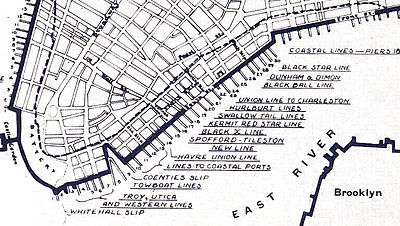Black Ball Line (trans-Atlantic packet)

The Black Ball Line was a passenger line founded by a group of New York Quaker merchants headed by Jeremiah Thompson, and included Isaac Wright & Son (William), Francis Thompson and Benjamin Marshall. All were Quakers except Marshall. The line initially consisted of four packet ships, the Amity, Courier, Pacific and the James Monroe. All of these were running between Liverpool, England and New York City. This first scheduled trans-Atlantic service was founded in 1817. In operation for some 60 years, it took its name from its flag, a black ball on a red background.
In 1851, James Baines & Co. of Liverpool entered the packet trade using the same name and flag as the New York company, despite its protests. Thus, for about twenty years, two "Black Ball lines" under separate ownership were operating in direct competition on the transatlantic packet trade. James Baines & Co. also operated ships running between Liverpool and Australia, including famous clipper ships such as Champion of the Seas, James Baines, Lightning, Indian Queen, Marco Polo and Sovereign of the Seas.
The Black Ball Line is mentioned in several sea shanties, such as "Blow the Man Down," "Homeward Bound", "Bullgine Run", "New York Girls", and "Hurrah for the Black Ball Line."
List of Black Ball Line (USA) ships
| Year (?) | Name | Tonnage | Shipyard | Status/fate |
|---|---|---|---|---|
| 1815 | James Monroe | aground in 1850 off the Tasmanian coast | ||
| Pacific | ||||
| 1816 | Amity | 382 BRT | New York | stranded on 24 April 1824 in Manasquan |
| 1822 | James Cropper | |||
| 1843 | .jpg) Montezuma | 924 BRT | William H. Webb, New York | stranded on 18 May 1854 in New York |
| 1844 | Yorkshire | 996 BRT | William H. Webb, New York | in February 1862 lost on the trip from New York |
| 1845 | Fidelia | 895 BRT | William H. Webb, New York | |
| Courier | ||||
| 1846 | Columbia | 1050 BRT | William H. Webb, New York | |
| 1847 | Isaac Wright | 1129 BRT | William H. Webb, New York | fell on fire on 23 Dec. 1858 on the Mersey and sank |
| Orpheus | ||||
| 1850 | Manhattan | 1299 BRT | William H. Webb, New York | broke out on 14 March 1863 Liverpool en route to New York, disappeared |
| 1851 | Isaac Webb | 1359/1497 BRT | William H. Webb, New York | went to the dissolution of the Black Ball Line for Charles H. Marshall & Co. and sank on 25 October 1880 |
| 1851 | Great Western | 1443 BRT | William H. Webb, New York | |
| Eagle | ||||
| Orbit | ||||
| Nestor | ||||
| William Thompson | ||||
| Albion | ||||
| Canada | ||||
| Britannia | ||||
| 1854 | 1383 BRT | sank 31 December 1875 after a collision, in the Irish Channel | ||
| 1855 | James Foster, Jr. | 1410 BRT | William H. Webb, New York | was in 1881 as a Hudson sold to German owners |
| 1855 | Neptune | 1406 BRT | William H. Webb, New York | ran in April 1876 to the Nova Scotia coast and broken |
| 1860 | Alexander Marshall | 1177 BRT | William H. Webb, New York | sank 1869 in the North Atlantic |
| 1869 | 1683 BRT | William H. Webb, New York | In 1887 sold to Norway as Sovereign and took fire on 20 March 1891 at the coal loading |
References
- Stephen Fox, Transatlantic: Samuel Cunard, Isambard Brunel, and the Great Atlantic Steamships, Harper Collins (2003) ISBN 0-06-019595-9, pp. 3–16 (introductory chapter on sailing packets).
- Transatlantic WNYC Reading Room (reproduces chapter referred to above)


